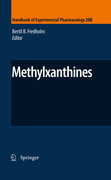
In the present volume of the Handbook of Experimental Pharmacology well knownexperts describe the actions of different xanthines with a focus on caffeine and theophylline. A special chapter is devoted to theobromine, an active component of chocolate, the actions of which are less well characterized. This bookalso presents the pharmacology of one xanthine derivative, propentofylline, as an example of a xanthine that has gone through extensive development for a novel therapeutic area. 21 contributions written by world experts in the field Provides an up-to-date and authoritative account of the pharmacology of methylxanthines Discusses the actions of the different xanthines and the mechanisms involved INDICE: From the contents: Brief history of methylxanthine use. Distribution of methylxanthines in plants with comments on possible evolutionary origins. Pharmakokinetics and metabolism of natural methylxanthines in animals and man. Phosphodiesterase inhibition. Ryanodine receptors and calcium. Adenosine receptor antagonism. Theobromine and the pharmacology of cocoa. Pentoxifylline. Propentofylline. Methylxanthines, seizures and excitotoxicity. Methylxanthinesand neurodegenerative disease. Methylxanthines and pain. Methylxanthines during pregnancy and early postnatal life. Methylxanthines and sleep. Methylxanthines and the kidney. Cardiovascular effects of methylxanthines. Methylxanthinesin asthma. Methylxanthine effects on inflammatory cells. Methylxanthines, inflammation and cancer. Methylxanthines and drug dependence. Methylxanthines andreproduction. Methylxanthines and human health. Epidemiological and experimental evidence.
- ISBN: 978-3-642-13442-5
- Editorial: Springer
- Encuadernacion: Cartoné
- Páginas: 760
- Fecha Publicación: 16/09/2010
- Nº Volúmenes: 1
- Idioma: Inglés
